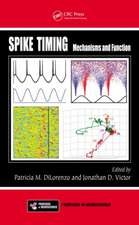Neurobiology of Depression: Frontiers in Neuroscience
Editat de Francisco Lopez-Munoz, Cecilio Alamoen Limba Engleză Hardback – 9 sep 2011
The book begins by discussing animal, neurophysiological, and neuropsychological models of depression as well as neural foundations. It explores genetic factors that contribute to depression and describes the effect of monoaminergic systems in the central nervous system.
Next, the book profiles the rise of psychopharmacology in the treatment of depression and the research into serotonin and monoamine reuptake inhibitors. It examines the role of the glutamatergic, endocannabinoid, and opioid systems in the pathophysiology of mood disorders, as well as the effect of biological rhythms on the human body.
Later chapters review the role of CRF-related ligands, CRF receptors, HPA axis activity, and glucocorticoid receptors in the regulation of the stress response and depression. They also describe cytokine modulation of molecular mechanisms. They examine the role of neuropeptide Y, nitric oxide, beta-arrestins, BDNF, and phosphodiesterases, and discuss the use of tachykinin antagonists in treatment. Finally, they analyze the neurobiological basis for the development of new antidepressant agents.
Exploring myriad aspects of a disease that plagues a large percentage of the population worldwide, this volume captures the state of the science of this debilitating disorder, facilitating further research and discovery.
Din seria Frontiers in Neuroscience
- 27%
 Preț: 1048.22 lei
Preț: 1048.22 lei - 18%
 Preț: 969.43 lei
Preț: 969.43 lei - 9%
 Preț: 319.88 lei
Preț: 319.88 lei - 5%
 Preț: 424.26 lei
Preț: 424.26 lei - 9%
 Preț: 320.30 lei
Preț: 320.30 lei - 14%
 Preț: 315.76 lei
Preț: 315.76 lei - 24%
 Preț: 435.02 lei
Preț: 435.02 lei - 15%
 Preț: 566.66 lei
Preț: 566.66 lei - 25%
 Preț: 456.63 lei
Preț: 456.63 lei - 15%
 Preț: 503.98 lei
Preț: 503.98 lei - 10%
 Preț: 326.59 lei
Preț: 326.59 lei - 18%
 Preț: 1333.33 lei
Preț: 1333.33 lei -
 Preț: 465.42 lei
Preț: 465.42 lei - 5%
 Preț: 1101.07 lei
Preț: 1101.07 lei - 18%
 Preț: 1335.94 lei
Preț: 1335.94 lei - 18%
 Preț: 1352.99 lei
Preț: 1352.99 lei - 18%
 Preț: 1364.09 lei
Preț: 1364.09 lei - 18%
 Preț: 1355.43 lei
Preț: 1355.43 lei - 18%
 Preț: 1342.79 lei
Preț: 1342.79 lei - 9%
 Preț: 322.18 lei
Preț: 322.18 lei - 30%
 Preț: 1014.67 lei
Preț: 1014.67 lei - 30%
 Preț: 1017.59 lei
Preț: 1017.59 lei - 28%
 Preț: 1046.00 lei
Preț: 1046.00 lei - 22%
 Preț: 323.27 lei
Preț: 323.27 lei - 29%
 Preț: 1018.16 lei
Preț: 1018.16 lei - 18%
 Preț: 1155.27 lei
Preț: 1155.27 lei - 30%
 Preț: 1016.87 lei
Preț: 1016.87 lei - 28%
 Preț: 1045.38 lei
Preț: 1045.38 lei - 27%
 Preț: 1047.86 lei
Preț: 1047.86 lei - 28%
 Preț: 987.07 lei
Preț: 987.07 lei
Preț: 1348.29 lei
Preț vechi: 1644.26 lei
-18% Nou
Puncte Express: 2022
Preț estimativ în valută:
257.98€ • 270.81$ • 214.14£
257.98€ • 270.81$ • 214.14£
Carte tipărită la comandă
Livrare economică 10-24 aprilie
Preluare comenzi: 021 569.72.76
Specificații
ISBN-13: 9781439838495
ISBN-10: 1439838496
Pagini: 526
Ilustrații: 58 b/w images, 8 color images and 19 tables
Dimensiuni: 178 x 254 x 36 mm
Greutate: 1.07 kg
Ediția:New.
Editura: CRC Press
Colecția CRC Press
Seria Frontiers in Neuroscience
ISBN-10: 1439838496
Pagini: 526
Ilustrații: 58 b/w images, 8 color images and 19 tables
Dimensiuni: 178 x 254 x 36 mm
Greutate: 1.07 kg
Ediția:New.
Editura: CRC Press
Colecția CRC Press
Seria Frontiers in Neuroscience
Public țintă
Researchers in neuroscience, neuropsychology, psychiatry, and psychopharmacology; mental health practitioners; psychologists; and graduate and post-graduate students.Cuprins
Animal Models of Depression. Neurophysiological and Neuropsychological Models of Depression. Neural Foundations of Major Depression: Classical Approaches and New Frontiers. Genetic Regulation of Emotion Brain Circuitries. Development of Brain Monoaminergic Systems. Contribution of Pharmacology to Development of Monoaminergic Hypotheses of Depression. Serotonergic Pathways in Depression. Noradrenergic System in Depression. Glutamatergic System and Mood Disorders. Role of the Endocannabinoid System in Etiopathology of Major Depression. Opioid System and Depression. Chronobiological Rhythms, Melatonergic System, and Depression. Corticotropin-Releasing Factor and Hypothalamic–Pituitary–Adrenal Axis Regulation of Behavioral Stress Response and Depression. Depression and Cytokine-Regulated Pathways. Tachykinins and Tachykinin Receptor Antagonists in Depression: Therapeutic Implications. Role of Neuropeptide Y in Depression: Current Status. Nitric Oxide Signaling in Depression and Antidepressant Action. Beta-Arrestins in Depression: A Molecular Switch from Signal Desensitization to Alternative Intracellular Adaptor Functions. Brain-Derived Neurotrophic Factor and Major Depression. Role of Cyclic Nucleotide Phosphodiesterases in Depression and Antidepressant Activity. Vascular Depression: A Neuropsychological Perspective. Neurobiological Basis for Development of New Antidepressant Agents. Index.
Notă biografică
Francisco López-Muñoz’s main research areas are the postnatal development of mammals’ pineal gland after chemical sympathectomy, the biological bases of drug abuse, psychiatric disorders and dual diagnosis. He also studies psychotropic drug interactions, the neurobiology of aggressivity, the bibliometric techniques applied to mental health-related disciplines and neuropsychopharmacology, the combination therapies with antidepressant and antipsychotic drugs and the history of the psychopharmacology. Dr. López-Muñoz is editor/author of 14 books and 137 chapters of books related to the psychopharmacology.
Cecilio Álamo’s research focuses on the field of neuropsychopharmacology, especially in the area of antidepressants, antipsychotics and analgesics. He has supervised several doctoral theses addressing the pharmacological analysis of mechanisms of action and the tolerance of and dependence on morphine and other analgesics. He has studied the non-endocrinological properties of TRH as an analgesic and anticonvulsant and developed research into new analgesics and antidepressants with serotonergic activity, patenting two of them. He is presently conducting research in pharmacoeconomics, bibliometrics and neuropsychopharmacology. He has published over 70 papers, nearly two dozen books, 100 book chapters and more than 300 papers in Spanish scientific journals.
Cecilio Álamo’s research focuses on the field of neuropsychopharmacology, especially in the area of antidepressants, antipsychotics and analgesics. He has supervised several doctoral theses addressing the pharmacological analysis of mechanisms of action and the tolerance of and dependence on morphine and other analgesics. He has studied the non-endocrinological properties of TRH as an analgesic and anticonvulsant and developed research into new analgesics and antidepressants with serotonergic activity, patenting two of them. He is presently conducting research in pharmacoeconomics, bibliometrics and neuropsychopharmacology. He has published over 70 papers, nearly two dozen books, 100 book chapters and more than 300 papers in Spanish scientific journals.
Descriere
With excerpts from international specialists in the field of neurobiology, this book presents state of the art research on the neurobiological aspects of depression. It discusses opioid and endocannabinoid systems and depression and explores other sources for depression provided by research in biochemistry, molecular biology, and genomics. Topics covered include genetic factors of depression; monoaminergic pathways and depression; serotonergic pathways and depression; melantonergic system, chronobiological rhythms, and depression; the significance of tachykinin mechanisms in depression; and the melatonergic system, chronobiological rhythms, and depression. This book serves as a reference for researchers in neuroscience and related fields, as well as graduate students.












